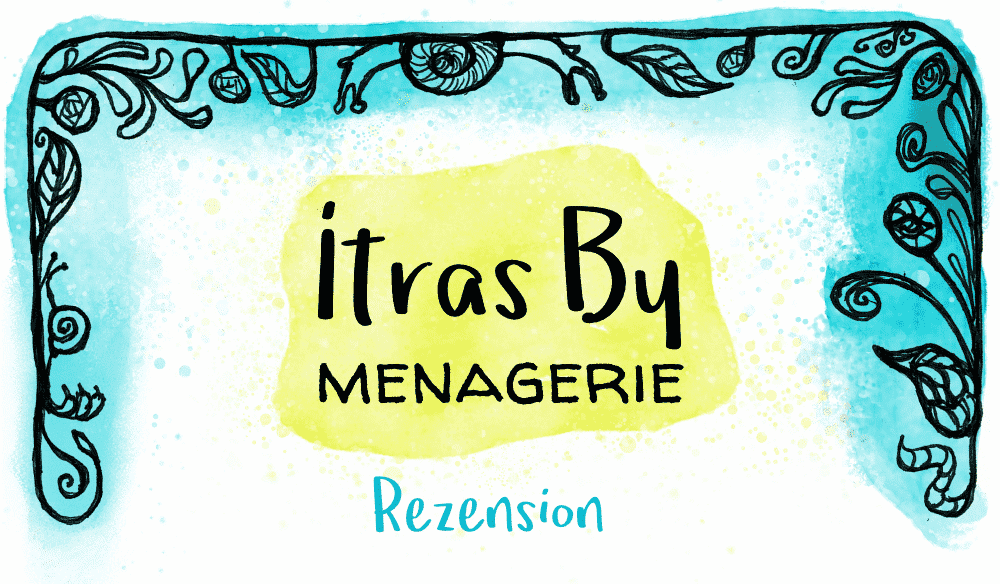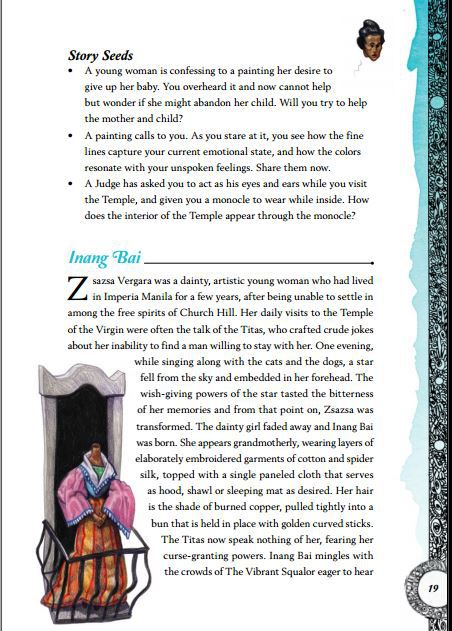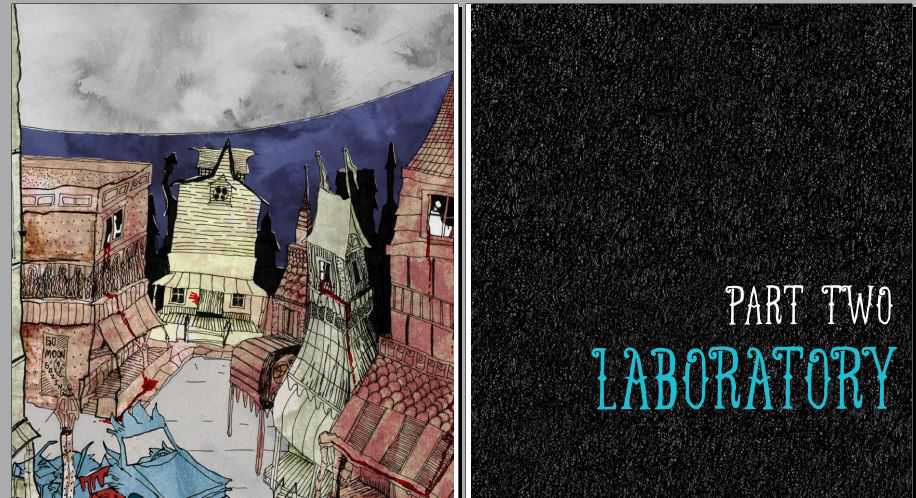Review: Itras By: The Menagerie
Von Tina Trillitzsch am 18. Oktober 2018English version of my review of the Itras By supplement Itras By: The Menagerie
2.500 Wörter, ungefähre Lesedauer 12 Min.
Looking for the original German version?

Introduction
Itras By: The Menagerie, published in 2017 by Vagrant Workshop, is an expansion for Itras By. But what is Itras By anyway? It’is a surreal, freeform role-playing game from Norway, with a German translation that’s been successfully funded on Kickstarter in early October 2018. The game is set in the eponymous fantastical 1920s city of Itras By and contains extensive setting material about the whole fictional city.
Itras By is situated, well, who knows - somewhere in the middle of nowhere, or in Europe? - and is inhabited by all sorts of whimsical individuals living in a number of bizarre neighborhoods. The players draw resolution cards where in other role-playing games they would roll dice, they and can introduce even more absurdities into the game using the so-called chance cards.
But the review subject itself, Itras By: Menagerie, is an “expansion”. This volume consists of contributions from countless international fans of Itras By, some of whom are not complete unknowns in the indie scene, and is illustrated by a wide variety of artists. It’s a cornucopia of new ways to play, inspiration of all kinds for people who have run out of ideas momentarily, as well as lots of game and game management aids. The contents are divided into five parts.
Part 1, Diorama, is a sort of colorful sampler of what to expect from the book: it contains a colorful mixture of material that could also be found in any of the following chapters - completely new scenarios, new neighborhoods, a closer look at (or re-examination of) existing neighborhoods, how to respectfully deal with certain themes in the game, and inspiring lists full of new game elements. Part 2, Laboratory, is an experimentation lab full of ideas on how to play Itras By in different ways or “get more out of it”; either costumed, without Itras By itself, without a game master, as a oneshot etc. Part 3, Dream Resumé, provides creativity tools for generating character ideas as well as inspiring lists of character concepts and names. Part 4, Hall of Mirrors, has original games and bigger scenarios and Part 5, Post Scriptum, is an assortment of personal essays and stories. Finally, the appendix has all kinds of things to print and make (cards, sheets, handouts). Below I’ll go into each chapter in a little more detail, discuss the book’s presentation and close with a final conclusion. If you are short on time, just read the brief overview above and then jump straight to the conclusion.
Contents
Foreword
Emily Care Boss (The Romance Trilogy) wrote the book’s preface, reflecting on her own experiences with Itras By. Then Ole Peder Giæver (co-author of Itras By) explains how to play Itras By with just this book - without even owning Itras By itself - using various examples from the following chapters for reference. Incidentally, the result is a good overview of what to expect.
Part 1: Diorama

This section begins with Tobie Abad’s (A Single Moment, Fiasco playset Bad Timing) Imperia Manila, a new district for Itras By full of magical realism based on the mythology of his homeland, the Philippines. There are a few story ideas for each sub-area, and last but not least a “curse table” in case you fall under one, which is not unlikely here.
Cabybaras with Hats is a short story starter by February Keeney about the titular capybaras and a bizarre phantom book club.
Matthijs Holter (Archipelago, Love in the Time of Seiđ) and Jackson Tegu (Monsterhearts expansion Second Skins, among others) discuss the respectful portrayal of sex work and sex in general in Itras By. They include inspiring questions to get the ball rolling as well as illustrative story ideas and NPC groups.
Edward “Sabe” Jones (Blazing Rose) takes a look at the “Dungeon” under the city, which is regularly plundered by hobby adventurers - from the indignant monsters’ point of view.
Terje Nordlin and Ole Peder Giæver offer detailed material on the Fringe Zones of Itras By, where anything is possible. Included is, among other things, advice on how to get there, how to give the adventure a structure and a purpose, as well as a random table for residents of the zone.
Philipp Neitzel (Aventurischer Bote) treats us to an interesting collection of ideas on how to use the radio as an element of the game, including a list of inspiring broadcasts and stations - e.g. one that keeps reporting exclusively on the life of one of the player characters.
And Aura Belle (A Real Game, You must break up with your Werewolf Boyfriend) presents a nightmarish scenario that turns the whole city into bloodthirsty moon vampires.
Part 2: Laboratory

Kat Jones (#Feminism: Glitzy Nails) talks about the merits of costumed play, both for Itras By at the table and when playing it as LARP. There are illustrated tips and suggestions for costumes from the different city districts as well as support for DIYing your own and sewing and crafting.
Keith Stetson (Seco Creek Vigilance Committee) provides a script on how to play Itras By as a oneshot, with tips and summaries that are pretty handy for introducing players even for campaign play. There are also lots of character ideas, including plot magnets and goals, to facilitate players jumping into the game more quickly.
Steve Hickey (Soth) teaches us how to introduce players to Itras By’s extensive setting world without having long monologues or just reading large portions of the core book to them.
Next, Ole Peder Giæver explains when (and how!) it can make sense to sometimes say no during play - as opposed to the improv stance of saying “Yes, but” that the game usually advises.
Jason Morningstar (Fiasco) tells us how to play Itras By without Itras By, that is, how to use the resolution and chance cards in other settings and game systems.
Becky Annison and Josh Fox (Lovecraftesque) explain how they play Itras By without an explicit GM (and prefer to call it “GM-ful” instead of GM-less).

Part 3: Dream Resumé
Keith Stetson and Clarissa Baut Stetson (Reconsolidation) give us an easy creativity tool with which you can help us come up with character concept in a playful way. Willow Palecek presents a long list of ready-made mini character concepts that you can expand using your own creativity. Ole Peder Giæver presents supremely useful name lists for the various city districts, while Niels Ladefoget Rasmussen offers a whole range of short multipurpose character concepts and names to go with them.
Part 4: Hall of Mirrors
Banana Chan (video producer for numerous indie RPG projects) penned a freeform game about the inner workings of the Grimasques, a group of outsiders with grotesquely frozen grimaces on their faces.
Kamil Wegrzynowicz (The Beast) presents a series of mini games to help you prepare for Itras By’s surrealism by stretching your surrealism muscle, while Aleksandra Sontowska (his The Beast co-author) introduces a longer game that helps players playfully fill the Black Bay district of Itras By with their own ideas.
Abstract Machine (Deconstruction) offers a scenario with custom rules where the players are members of a retrieval mission to rescue the scientists of the Itras-Troll Fringe Zone research station who, after unspeakable psychedelic dream experiences, are now in cryostasis. Play atmosphere is reminiscent of the Nordic Dreaming play style of Matthijs Holter’s Society of Dreamers.
Evan Torner (scholar of German film, #Feminism: Something to Drink with That, Sir?) completely re-imagined Itras By in the form of an expressionist German movie, using influences from various 1920s films (e.g. The Cabinet of Dr. Caligari). Ready-made characters from these films are confronted with each other in opening scenes and developed by the players.
Finally, this chapter contains an entirely new big introductory scenario for Itras By developed by Oliver Vulliamy et al. for the French edition of the game. It aims to give special support for new players and revolves around the fate of a missing artist.
Part 5: Post Scriptum
In a very personal essay, Martin Bull Gudmundsen (Itras By co-author) talks about the roles that RPGs, surrealism, and Itras By in particular, have played in his life with autism. Then both co-authors offer a surreal short story about an outsider in Itras By, followed by a brief overview of how Itras By: Menagerie came about and of each contributor.
Appendix
In the appendix, you’ll find a beautifully designed character sheet for Itras By, ready-to-print versions of the handouts from inside (especially a brief overview of the city neighborhoods), and a new set of chance and resolution cards to print and make.
Design and Usability

I read and reviewed the PDF version of this book on a 10.1 inch Android tablet. As far as I can tell, the layout of the printed edition is identical.
Let’s start with the PDF’s usability. Bookmarks are linked and the table of contents on page 4 (PDF) is clickable and automatically takes you to the desired page, which is a good start that not every RPG PDF offers. Links to websites are also active. I would have liked to have clickable links whenever there were internal page references in the book, as well, for example an article on character ideas referring to one with name lists on another page. The font size was quite comfortable to read on my tablet and I never felt the need to zoom.
About the design, fonts and layout: These are mostly identical to the Itras by core book, as far as I can tell. The most noticeable change is a different base color of blue instead of yellow. I like the choice of fonts very much, they are unobtrusive and still look unique at the same time. The headlines are a light turquoise, which looks very nice, though could possibly use more contrast with the page background for accessibility reasons. I didn’t have any difficulty with readability myself, though (although I’m beginning to need reading glasses now and then).
As with Itras By, I really love the layout here and I think Kathy Schad, who created the concept, deserves much praise for her excellent work all around (she also did the designs for FreeFate and Earthdawn: Age of Legend, which both look very nice indeed, too) - she’s been a huge inspiration for my own humble layout efforts. Sketched decorative elements and illustrations break up the text nicely and go very well with with the contents. Have I mentioned that the illustrations are also from many different international contemporary illustrators, complemented by historical illustrations and photos from the 1920s?
The editing is great; I didn’t spot a single typo, grammar error or awkward turn of phrase. Chapter labels telling you which section and subsection of the book you’re currently in do exist, but unfortunately aren’t used as continuously as in the core book, which had labels on the edge of a page on each and every spread.
Conclusion
The general concept: I think it’s a fantastic idea to compile a book of content from such a diverse range of contributors from different countries, in both articles and illustrations, to get a broad variety of viewpoints on Itras By. I’m pleased that the share of non-male contributors is quite high compared to many other RPG publications. A slight imbalance is still discernible, though, where non-Western countries are concerned; I think Tobie Abad from the Philippines may actually be the only one. Despite having so many different contributors, the whole volume feels like one cohesive piece, which is mainly due to the fact that individual articles keep referring to others in the same book. (Really, how did they do that? All the cross-referencing must have been a lot of work!) I just love the visual design; the text is easy to read on a tablet due to good layout and font choices - combined with the illustrations, the book is a true feast for the eyes! The design is strongly based on the Itras By core book, which looked great as well. I’m also very happy with the book’s content: It’s packed with helpful hints to make the game easier and even more fun to play, while at the same time it’s not a must without which the base game is in any way incomplete. Just lots of add-ons that are very nice to have indeed.
A few pieces I particularly enjoyed include Keith Stetson’s article Running an Itras By One-Shot in Part 1, which is intended for fitting a self-contained story into a single session. But thanks to the play aids and summaries it offers, it also lends itself well to being a general introduction to the game, even if you are planning to play longer campaigns. As a kind of quick start, it also deals with something that I find particularly difficult in Itras By (and other free-form games): coming up with a character concept from scratch. A few more articles in Part 3 are concerned with the same thing in some shape or form. A Method to Producing Ideas, also by Keith, together with Clarissa Baut Stetson, features a kind of game board with random terms randomly scattered about which you can pick using various randomization methods to combine and develop into concepts for your own characters. Willow Palecek and Niels Ladefoget Rasmussen make it even easier in Character Seeds and A Collection of Curious Characters by offering a long list of concise, ready-made character ideas to flesh out on your own.
Cartography of the Unreal by Steve Hickey is all about the city itself, specifically how to succinctly introduce it to the players. The quick summary of the neighborhoods is a particularly useful tool, as are his tips for creating your own locations within the neighborhoods, because that’s something I often struggle with myself. I also liked how he applies the Dungeon World concept of drawing maps while leaving blanks to Itras By.
Saying No by Ole Peder Giæver describes how to integrate different ways of saying no into the game to stop things you find inappropriate or unpalatable. He even discusses the “Try a different way” phrase from Matthijs Holter’s sister game Archipelago, which is particularly dear to my heart, and introduces a so-called “Nø card”, which bears a certain resemblance to John Stavropoulos’ popular X card (GoogleDoc).
Overall, I think it’s absolutely worth it to get Itras By: Menagerie if you already like Itras By, and even without it, it contains several tools you can use in any game. It’s available in PDF or print from about $15.
Finally, I’d like to thank Vagrant Workshop and Ole Peder for a review copy, which I already received, to my great embarrassment, about a year ago, and which was actually intended for my personal RPG blog, which has gone into a bit of a hibernation since then.
Image credits
Header illustration: Tina Trillitzsch, internal images: screenshots of the PDF (Vagrant Workshop)